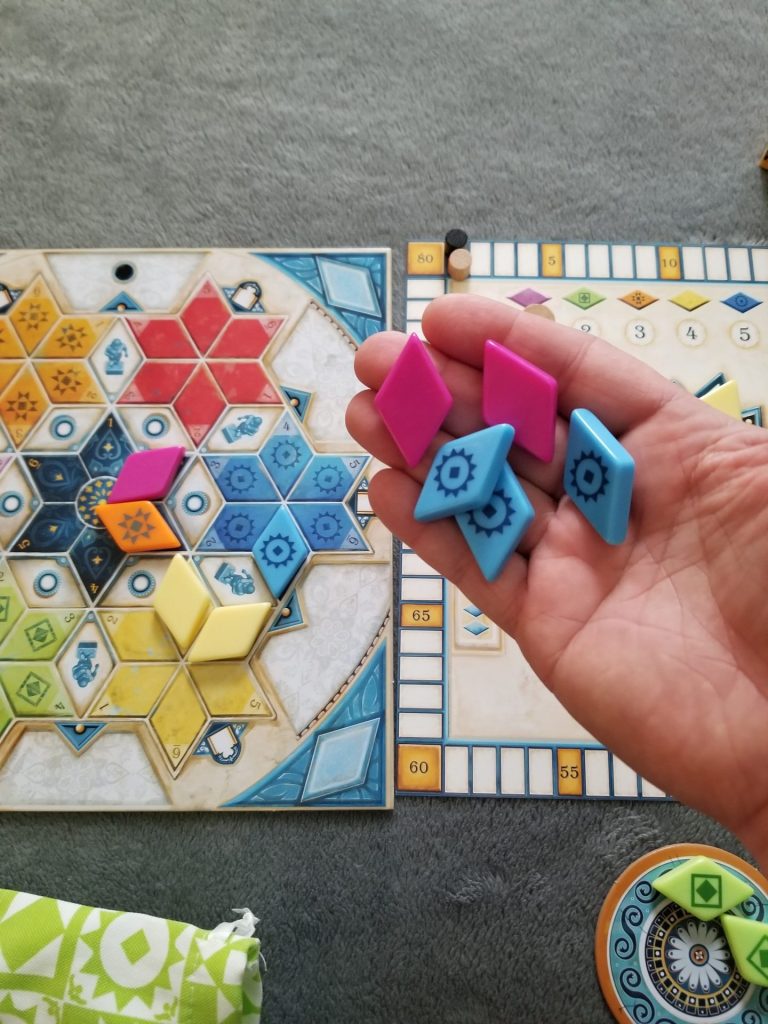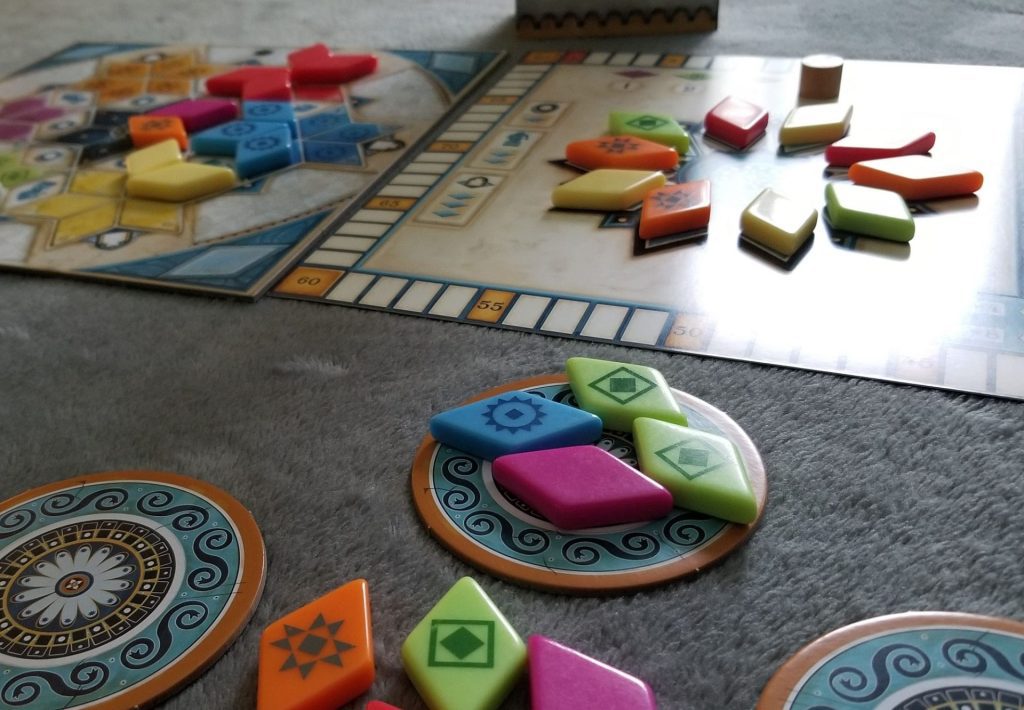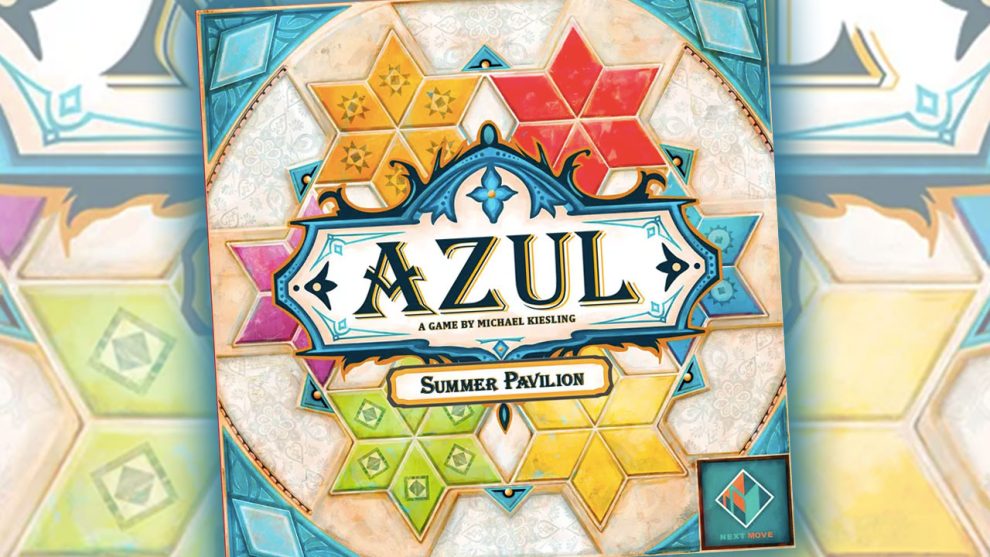Disclosure: Meeple Mountain received a free copy of this product in exchange for an honest, unbiased review. This review is not intended to be an endorsement.
Before his death, according to Azul: Summer Pavilion’s (Pavilion) rulebook, King Manuel I of Portugal had a lot of grandiose plans. After his success decorating the walls of the Palace of Evora (Azul) and the windows of the Sintra National Palace (Stained Glass of Sintra), the King also had in mind a summer pavilion to honor the most famous members of the royal family. It was going to be a beautiful structure, built and decorated by the most talented artisans that the Portuguese empire had to offer. Unfortunately, he died before construction ever began.
Azul: Summer Pavilion imagines a world in which this vision came to fruition. The players take on the roles of the artisans tasked with bringing the structure to life. Each round, they will be drafting tiles from a central display and then adding those tiles to their player mats in order to score points. Once the final round ends, the player with the most points wins.
Of course, this is a very high level overview of the game. If you just want to know what I think about it, feel free to skip ahead to the Thoughts section. Otherwise, read on as we learn how to play Azul: Summer Pavilion.
Setup
This is how you set up a game of Azul: Summer Pavilion:

A number of Factory Displays (based on player count) are arranged in a circle in the middle of the table. In between these is placed the 1st Player tile. The central game board is placed next to the Factory Displays along with the cardboard tower.
The Round marker is placed onto the first space of the Round track on the central board. The tiles are placed into the bag, mixed well, and then ten are drawn and placed into the spaces in the center of the central game board. Then tiles are drawn from the bag and placed onto the Factory Display tiles so that each one has four tiles placed onto it.
Next, each player is given a player board, colored side up (or, if everyone agrees, everyone can play with the other, more advanced side which is not covered in this review). The players also select a color and place their matching scoring marker onto the ‘5’ space of the scoring track of the central game board.
Finally, a start player is chosen and you are ready to begin.
Tile Selection
Each round, there is a ‘joker’ color in play (indicated by the Round marker on the central game board). This ‘joker’ is a wild color and can be used to cover the costs associated with placing any color of tile onto a player’s board.
On a player’s turn, they will select all tiles of the same color, along with a single tile of the ‘joker’ color if one is present, from any one of the Factory Displays or the center, to take into their possession. If the player took tiles from a Factory Display and there were any leftover tiles, those tiles are moved to the center between the Factory Displays. If the selected tiles were taken from the center, nothing happens unless the 1st Player marker is still there, in which case, the player takes that as well.
The main takeaway here is that a player must always take all tiles of the same color plus no more than one ‘joker’ tile if one is present. Players may never opt to take all tiles of the current ‘joker’ tile color either. They must choose something else.
Tile Placement
The tile selection goes around the table, from player to player, until all tiles have been selected. Then the players may begin placing their selected tiles onto their player board.
Each space on the player board has two distinct characteristics: a color and a number. The color dictates what color of tile can be placed onto the space. The star in the center of the player board may only accept a single tile of each color. Every other star is one specific color.
The number dictates how many tiles of that color must be used to place a tile there. For instance, if the space is a blue 5, then the player must have five blue tiles in their possession (or some mixture of blue and ‘joker’ color tiles that add up to five). They will then discard four tiles into the tower and place the last tile onto the blue 5 space of their player board and then score their points for doing so (which I’ll get to momentarily).

If this tile placement should cause either a column, a statue, or a window to become surrounded, the player immediately gains one, two, or three tiles (respectively) of their choice from the central game board. Then the now empty spots are filled in with tiles drawn from the bag.
If there should ever be a time when the players are expected to draw tiles from the bag and the bag is empty, they will then empty the contents of the tower into the bag, mix well, and then continue drawing from the bag.
Ostensibly, the tile placement phase is supposed to be done, one tile placement at a time, in player order. Realistically, though, all players can do this simultaneously as long as (a) nobody cheats and (b) nobody will be taking tiles from the central game board.
Once everyone has placed all the tiles that they can, the round ends. If a player has any tiles remaining, they may select up to four to carry over into the next round. All others must be discarded into the tower and the player will lose a single point for each tile discarded in this way.
Scoring
Just like Azul, the scoring is the most complex aspect of the game.
During the tile placement phase, each tile scores a single point for itself, plus an additional point per each tile that is connected to it in the same star, in the same cluster. For instance, if two tiles had been placed next to each other across a single tile gap of another two connected tiles and a fifth tile is placed in between them, that fifth tile will score five points: one for itself and one for each of the tiles that are now connected to it (one point times four tiles).

At the end of the sixth round, the game ends. Additional points are awarded for filling in all the locations on the stars (points vary per star color), filling in all the 1s on all of the stars, filling in all of the 2s on all of the stars, and likewise for the 3s and 4s. The 1s, 2s, 3s, and 4s score regardless of each other. You don’t have to have filled in all of the 1s and 2s to score for the 3s, for instance.
After this final scoring, the player with the most points wins.
Thoughts
Full disclosure: I have only ever played three games in the Azul series, the base game that started it all (love it), Stained Glass of Sintra two or three times a couple of years ago (like it), and this game, Summer Pavilion. I am aware that, at the time of this writing, there is a fourth game in the series: Queen’s Garden, but I do not have any personal experience with it.
You might be thinking that it seems a bit weird starting things off with a disclaimer and, I’ll admit, that yes, it is. But I felt like it was necessary because I want to be fully transparent with you up front so that you’ll know where I’m coming from when I tell you: I don’t like this game.
Don’t get me wrong. Taken on its own merits, Azul: Summer Pavilion is actually a pretty decent game. The game looks attractive on the table. It’s easy to teach and play. There are a lot of interesting decision points and there’s a whole lot of strategy baked into the game’s DNA.
The problem is that it feels exactly like Azul when I am playing it. Sintra gave me the same feeling, but at least the addition of the glazier and having to manage its movements added an extra layer that made the game feel differentiated enough that I didn’t find myself constantly thinking about how I’d rather be playing Azul. I can’t say the same for Summer Pavilion. Other than the pieces being shaped differently (rhombuses instead of squares) and the ability to set aside four pieces to carry into the next round, there’s really not enough to set the two apart. The different joker each round does add an extra layer, but that layer is wafer thin. It just isn’t enough.

I also take issue with the theme. What am I actually building? I get extra tiles from the central display for surrounding statues, windows, and columns, but what am I actually surrounding them with? What do the tiles in the game actually represent? In Azul, I was placing azulejo tiles onto the walls. In Sintra, I was creating stained glass. The components meshed with the theme and everything made some kind of sense. But I have no idea what I’m actually supposedly doing in this game other than placing game components to score points.
Another thing that aggravates me about the game, and every Azul game if I’m being honest, is the way that discarded tiles are treated. Azul had you throw the discarded tiles back into the box and this created some awkward moments when you had to pour the tiles from the box back into the empty bag once the bag ran out of tiles. Beginning with Sintra, they began adding a discard tower into the mix. That’s fine. It’s much easier to empty the tiles from the discard towers back into the bag, but those towers (a) are unwieldy and take up a lot of space in the box and (b) get in the way when they’re out on the table. Whenever we play, we’re constantly having to shift the discard tower around because it invariably winds up blocking someone’s view regardless of where it sits on the table.
Why not just give us a second bag? Wouldn’t that be a much simpler, more elegant solution? Just let me place discarded tiles into the second bag. Then, when the first bag runs out, all I need to do is begin drawing from the second bag. Not only would it save space inside the box, but it would also free up a lot of space on the table itself.
I simultaneously do and do not like this game and that just feels weird. As such, I wouldn’t recommend it to anyone, not even people who have never played an Azul game before. If that’s you, just play Azul. It’s just as fulfilling as Summer Pavilion, but with less rules overhead. And it’s just a much better game.












Add Comment